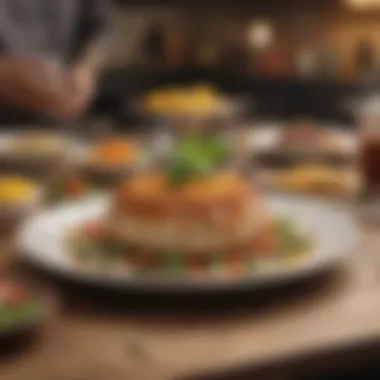Exploring Virtual Parties in the Culinary Sphere


Intro
The rise of technology has reshaped many facets of our lives, and culinary gatherings are no exception. Virtual parties emerge as a notable phenomenon in the culinary sphere, where food lovers come together to cook, share, and engage in a communal experience, even from a distance. This new form of gathering challenges traditional concepts of dining, introducing unique dynamics that not only affect the way food is prepared and consumed but also how community is built and maintained.
In this exploration of virtual culinary gatherings, we aim to dissect the various aspects that contribute to their popularity and effectiveness. From the initial concept of virtual parties to the intricate details of organizing them, each section will provide insights that are both practical and strategic. Featuring storylines of successful online gatherings, we will examine the art of theme selection, participant engagement, and how to create an inviting atmosphere that rivals the physical experience. Moreover, we will discuss how these virtual interactions foster a sense of belonging within diverse culinary enthusiasts.
Operating in a digital space means adapting our culinary practices to fit this new mold. This article seeks to illuminate the best ways to embrace technology to create memorable culinary experiences online, blending the joy of cooking with the convenience of digital connection.
Preface to Virtual Parties
Virtual parties have become a significant part of our social landscape, particularly in the culinary world. They represent not just a way to gather but also a new method of interaction among food lovers. Understanding the dynamics involved in planning and executing virtual parties can offer great benefits. These gatherings enable participants to explore their culinary skills and share experiences without the constraints of physical space.
One cannot underestimate the value of virtual parties as not only a social engagement but as a community builder. They offer a unique opportunity to connect with others who share similar passions for food, cooking, and gastronomy. This connection often develops into deeper relationships, enhancing participation in future events. Moreover, they can foster an inclusive atmosphere, allowing individuals from varied backgrounds to come together over a shared interest in cuisine that might not have been possible in a traditional physical setting.
Definition and Overview
A virtual party can be defined as an online gathering where individuals connect through digital platforms. These parties can involve cooking, sharing recipes, or simply enjoying food together while apart. Participants communicate via video conferencing tools, chat apps, or sometimes even via social media. The essence of a virtual party lies in its ability to replicate the feel of a face-to-face gathering, without the geographical limitations.
Embracing the digital era, virtual parties often include interactive components. For instance, hosts may create themed cooking sessions or allow participants to showcase their culinary presentations. By blending technology with culinary experiences, participants are invited to engage actively, thus enriching the overall atmosphere. This interaction sets virtual parties apart from merely watching cooking shows online; it transforms observation into an engaging activity.
History and Evolution of Virtual Gatherings
The origins of virtual gatherings can be traced back to the early days of the internet, but they gained real traction during global events that necessitated social distancing. As face-to-face meetings became limited, many individuals turned to technology for connection. Platforms like Zoom, Google Meet, and Microsoft Teams emerged as essential tools for maintaining personal and social ties.
In the culinary scene, this evolution has proven particularly impactful. Chefs and culinary enthusiasts adapted to virtual formats by hosting live cooking demonstrations and interactive workshops. They began sharing their culinary skills with a broader audience, breaking down barriers. Over time, these virtual gatherings have evolved. They now encompass a range of styles, from casual get-togethers with friends to professionally organized culinary events.
Virtual parties no longer serve merely as a substitute for physical gatherings. They have carved their own niche, enriching the culinary community in ways traditional setups often could not. As technology continues to advance, the future of virtual parties appears to hold even greater potential for innovation and engagement, signaling a fundamental shift in how we connect and share culinary experiences.
The Role of Technology in Virtual Parties
Technology stands as a pivotal force in the genesis and evolution of virtual parties, especially in the culinary domain. The shift to virtual gatherings over the past few years has expanded not only the reach of these events but also the creative possibilities. With the integration of various tools and platforms, participants can now engage with one another in more interactive and immersive ways than traditional gatherings allow. This segment explores the significance of technology in establishing a conducive environment for culinary fans to connect, share, and grow within a digital space.
Platforms for Hosting Virtual Events
The choice of platform can greatly influence the overall experience of a virtual party. Some widely-recognized options include Zoom, Microsoft Teams, and Google Meet. Each of these platforms offers unique features that can cater to various needs. For instance, Zoom allows for breakout rooms, which enable smaller group discussions. This can be especially useful in culinary parties where participants might want to work on specific recipes or techniques in groups.
When selecting a platform, considerations include:
- User Accessibility: Ensure that participants can easily join. A straightforward link without complicated login requirements can encourage participation.
- Features: Consider the tools available, such as screen sharing or recording options for future reference.
- Participant Limits: Different platforms have varied limits for the number of participants. Make sure the platform can accommodate your expected guest list.
Choosing the right hosting platform is essential, as it sets the tone for the entire event. If the technology fails or is not user-friendly, the experience can be frustrating and detract from the engaged atmosphere expected in culinary gatherings.
Essential Tools for Successful Engagement
Merely having a platform does not guarantee engagement. Various tools help facilitate interaction and bolster the sense of community. Some essential tools include:
- Polling Software: Tools like Polleverywhere or Mentimeter allow hosts to gather instant feedback and opinions from participants, which can be used to drive discussions or adapt the event in real time.
- Social Media Integration: Using platforms such as Facebook or Instagram during the event can enhance interaction. Participants may share pictures of their dishes live, creating a shared experience.
- Recipe Sharing Software: Tools like Google Docs or cloud storage can be used to share recipes and notes in real time, ensuring that everyone has access to the same information.
Engagement is the heart of any virtual party, and with the correct tools, hosts can create a rich, interactive experience. Keeping the energy alive through technology ensures that culinary enthusiasts feel connected, even when miles apart.
"Technology is an enabler; it can transform how we connect, learn, and share experiences with others. In culinary contexts, this is especially meaningful as it enhances the sharing of not just food, but culture and stories."


The role of technology in virtual culinary parties cannot be overstated. As we embrace these modern gatherings, being aware of the available platforms and tools can further refine experiences, ensuring that the flavor of community remains intact, even in a digital landscape.
Planning a Virtual Party
Planning a virtual party is a crucial step that can greatly influence the overall experience for participants. Unlike traditional gatherings, which offer physical presence, virtual parties rely on thoughtful design and engagement strategies to foster connection and enjoyment. Successful planning involves understanding the dynamics of online interactions, ensuring that the culinary aspect remains vibrant, and creating an atmosphere conducive to socialization, even through a screen.
Selecting the Theme
Choosing a theme for a virtual party can set the tone and guide the entire experience. A well-selected theme can create excitement and anticipation among participants. It is helpful to consider seasonal occasions, culinary styles, or even popular trends in cuisine. For instance, one might choose a Mediterranean theme showcasing various dishes like hummus, tzatziki, and grilled vegetables. This not only provides culinary direction but also encourages guests to immerse themselves in the experience by dressing according to the theme or preparing culturally relevant recipes.
To enhance the theme, consider visual elements that can be incorporated into the virtual environment. Background decorations or coordinating outfits can create a cohesive feel.
Inviting Participants
Inviting the right participants is another vital aspect. A successful virtual event thrives on the interactions and contributions from its guests. Utilize digital platforms for creating invites, such as Eventbrite or Facebook Events, making sure to convey logistical details clearly, including the date, time, theme, and any specific preparation needed from attendees.
Personalized invitations can create a sense of exclusivity and encourage attendance. Consider reaching out directly through messaging apps to engage potential participants. This fosters connection even before the event.
Scheduling and Timing Considerations
Timing is often underestimated in the planning of virtual parties. Selecting an appropriate time ensures maximum attendance and engagement. It is important to consider time zones, especially if participants are spread across different geographical areas. Aim for a date and time that caters to the majority of attendees.
In addition to selecting the right moment, setting the duration of the event matters. Virtual parties can be exhausting when they extend for long periods. Aim for a duration of one to two hours, allowing time for cooking together, socializing, and enjoying the culinary creations.
Effective timing can make the difference between a memorable or forgettable virtual party.
In summary, planning a virtual party requires attention to detail and a clear understanding of how to cultivate an inviting environment. Selecting a themed approach, carefully inviting participants, and considerate scheduling create the foundation for a successful culinary experience that people will remember.
Culinary Elements in Virtual Parties
The culinary aspects of virtual parties serve as the foundation for a successful and enjoyable experience. These elements not only reflect the theme of the gathering but also facilitate a deeper connection among participants. As people gather in a digital environment, how they share, prepare, and present food can significantly enhance the experience. The act of cooking together can create a shared activity that promotes engagement and camaraderie, regardless of physical distance.
Menu Selection and Recipe Sharing
Selecting the menu is a critical step in planning any virtual culinary event. It sets the tone and gives participants something to look forward to. A well-curated menu can factor in participant preferences and dietary restrictions while keeping the overall theme in mind. Sharing recipes before the event builds anticipation and allows everyone to prepare in advance. This not only ensures that ingredients are ready but also creates a sense of community among participants.
Platforms like Reddit or Facebook can be helpful for exchanging recipes and ideas. A dedicated group or thread can facilitate discussions about menus and variations that participants might want to try. Additionally, focusing on seasonal ingredients can elevate the meal's quality and offer a fresh touch. Ultimately, the emphasis on collaboration in menu selection heightens the enjoyment of the experience.
Food Presentation in a Virtual Setting
Visual appeal plays a significant role in the enjoyment of food, even in a virtual context. Participants should consider how to present their dishes attractively, as this can enhance the overall atmosphere of the gathering. Using bright colors and diverse textures can make dishes visually appealing and invite discussions among participants.
Each person might showcase their plating technique during the event. This can lead to a virtual 'show and tell' moment, where attendees present their creations. Ensuring good lighting for the presentation can help make the food stand out in the video call. A well-presented dish is more likely to entice others to engage and share their thoughts, fostering interaction in a virtual environment.
Incorporating Dietary Preferences
Inclusions of dietary needs is essential in planning virtual parties. Participants may have different requirements due to health, preference, or ethical reasons. Addressing these can ensure that everyone feels considered and valued. When planning the menu, it is prudent to ask attendees about any dietary restrictions they may have. This ensures a diverse menu that caters to all.
Another approach is to provide options for participants to adapt recipes to their preferences. For example, suggesting substitutes in recipes can allow for flexibility. Creating a section for gluten-free, vegan, or vegetarian dishes can help participants navigate their choices more easily.
Being considerate of diverse dietary needs in virtual gatherings encourages inclusivity and shows respect for individual choices.
The incorporation of culinary elements in virtual parties emphasizes community, creativity, and shared experiences, transforming a digital gathering into something meaningful.


Engagement Techniques for Virtual Parties
Engagement is a crucial aspect of virtual parties, particularly in the realm of culinary experiences. The absence of physical presence can make it challenging for participants to feel connected. However, effective engagement techniques can transform an ordinary virtual gathering into a memorable event. Such techniques foster interaction and create a sense of community among attendees, essential for a successful virtual culinary experience. Let’s explore various strategies that can be implemented to enhance participant engagement.
Interactive Cooking Sessions
One of the most effective engagement techniques is conducting interactive cooking sessions. These sessions allow participants to cook together, guided by a host or a guest chef. This real-time participation helps in replicating the collaborative spirit of traditional cooking classes.
During these sessions, hosts should consider the following:
- Selecting Accessible Recipes: Choose recipes that are simple yet appealing, ensuring that all participants can follow along with ease.
- Real-Time Q&A: Allow participants to ask questions during the process. This keeps the interaction flowing and makes participants feel involved.
- Highlighting Techniques: Focus on basic cooking techniques that resonate with both novice and experienced cooks.
Interactive sessions also help build camaraderie. As participants cook together, they share tips and experiences, creating bonds that extend beyond the virtual realm.
Games and Culinary Challenges
Incorporating games and challenges can significantly elevate the energy of a virtual party. These activities not only add fun but also encourage competition and participation.
Some popular ideas include:
- Cooking Challenges: Set a time limit for participants to prepare a dish using specific ingredients or tools. This can be both entertaining and educational.
- Quizzes: Host culinary trivia that tests participants' knowledge of food, ingredients, and cooking techniques. This can lead to engaging discussions.
- Themed Costume Contests: Encourage participants to dress according to the culinary theme of the event. It lightens the mood and adds an element of visual fun.
Games and challenges should align with the event's culinary focus. They are a great way to engage participants, spark laughter, and make the gathering more lively.
Encouraging Participant Sharing
Encouraging participants to share their experiences during and after the virtual party can deepen engagement and create a sense of belonging. When attendees share their cooking results, recipes, and personal stories, it enriches the overall experience for everyone.
Ways to facilitate sharing include:
- Utilizing Social Media: Create a dedicated hashtag for the event where participants can post pictures of their dishes. This allows for ongoing interaction even after the party ends.
- Photo Contests: Motivate users to submit their best dish photo for a chance to be featured in future events. Recognizing participants boosts their involvement.
- Discussion Forums: Post-event, use platforms like Reddit or Facebook to continue conversations. This way, participants can exchange tips and connect with each other beyond the event.
"Sharing enhances community. When participants contribute, they create a richer tapestry of shared experiences."
Post-Event Considerations
In the realm of virtual parties, especially those centered around culinary experiences, post-event considerations serve as a crucial mechanism for improvement and engagement. The participation of guests does not end with a final toast; rather, it's paramount to cultivate ongoing dialogue and meaningful connections. This section delves into two fundamental aspects: feedback collection and analysis, alongside follow-up activities, which together offer a pathway to refining future events and maintaining participant interest.
Feedback Collection and Analysis
Feedback collection becomes essential after any virtual event. It allows hosts to grasp participant experiences while identifying strengths and weaknesses. Organizing surveys can be particularly effective. Questions may range from the relevance of the theme to the functionality of the platform used. Tools such as Google Forms or SurveyMonkey can provide structured formats that simplify the process.
Consider including the following types of queries:
- Did the event meet your expectations?
- What topics would you like to explore next?
- How would you rate the overall experience?
Additionally, qualitative feedback holds great value. Encouraging participants to share specific moments or suggestions can uncover insights that numerical ratings cannot. For instance, a participant might reveal that they enjoyed a cooking challenge but felt the timing was rushed, shedding light on areas needing adjustment.
Analyzing this feedback is not just about evaluation but about enhancing future culinary gatherings. Using tools such as Excel for data compilation can aid in spotting trends. Perhaps a consistent request for plant-based recipes emerges, highlighting a growing interest among attendees. This analytical phase ultimately allows hosts to tailor future menus and themes, creating an experience that resonates with culinary enthusiasts.
"Feedback can illuminate pathways to improvement that may not be visible otherwise."


Follow-Up Activities
Post-event follow-up activities contribute significantly to sustaining interest and fostering community. These actions serve not only to thank participants but also to keep the culinary conversation alive. A simple message expressing gratitude for attendance can go a long way. However, consider going beyond mere thank-yous.
For example, sharing recordings or highlights from the virtual event can maintain participant engagement. This could include sending out a recap email containing:
- Recipes shared during the event.
- Photos of participants’ culinary creations.
- Links to recorded sessions for anyone who missed specific segments.
Engaging participants on social media platforms can also extend the conversation. Consider creating a dedicated online group where members can continue discussions, share their own recipes, or post photos of dishes they prepare based on the virtual event. This sense of community can enhance the overall experience, allowing food lovers to connect with each other.
Additionally, you might employ follow-up surveys after a certain duration to assess how attendees implemented what they learned. Did they host their own virtual dinner parties? What culinary skills improved? This not only reinforces learning but strengthens bonds, establishing a foundation for future gatherings.
Case Studies of Successful Virtual Culinary Events
The exploration of successful virtual culinary events provides invaluable insights into the dynamics of hosting online gatherings centered around food. These case studies showcase not only creativity and innovation but also the practical implications and outcomes of well-executed virtual events. By examining these examples, we can unearth key elements that contribute to a successful experience in the culinary sphere, providing guidance for both novices and seasoned hosts.
Notable Examples from the Industry
Several virtual culinary events stand out as exemplary models due to their unique approaches and successful engagement strategies. A prime instance is Bistro Box, a venture initiated by several renowned chefs during the pandemic. This event allowed participants to cook alongside professional chefs in real-time, turning the cooking process into an interactive experience. Registrants received ingredient boxes delivered to their homes, making it easy to participate.
Another fascinating example is The Virtual Wine and Dine Dinner organized by a prestigious winery. This event combined a curated wine selection with an exclusive menu, featuring a live-streamed cooking demonstration. Participants interacted directly with both the chef and the sommelier, enhancing the culinary journey through professional insights into the wine-pairing process.
These events demonstrate that effective planning, curated content, and the use of engaging platforms are critical in creating memorable virtual experiences.
Lessons Learned from Failures
While successes are enlightening, failures also provide significant insights. A notable misstep occurred in Food Fest Live, where overwhelming registration led to technical difficulties, disrupting the experience for many. The event showcased how critical resource allocation and platform testing are before a large-scale online event.
Another example is Chefs Gone Wild, an adventurous event intended to take participants through an interactive cooking journey. However, it failed to manage participant expectations regarding the complexity of recipes. This mismatch resulted in frustration among attendees, illustrating the necessity of clearly communicating what participants can expect.
In summary, the field of virtual culinary events is rich with opportunities for learning, both from triumphs and pitfalls. Understanding the dynamics that lead to success and failure can help organizers create enriching experiences that transcend traditional culinary gatherings.
Future Trends in Virtual Parties
The landscape of virtual parties is constantly changing. As technology advances, so do the strategies used by hosts to create engaging culinary experiences online. This section highlights the importance of understanding these trends, as they are essential for anyone involved in organizing virtual culinary events. New innovations and social media dynamics play crucial roles in shaping experiences. Adapting to these trends can elevate the overall experience for participants.
Innovation in Culinary Virtual Experiences
Innovation is at the forefront of enhancing virtual gatherings. New technologies and platforms are emerging that allow for more interactive and immersive experiences. Virtual reality (VR) and augmented reality (AR) are two areas gaining traction. These technologies enable participants to engage with a cooking class or culinary demonstration in a more visual way. Hosts can transport participants to a kitchen or market, enriching the experience beyond simple video.
Additionally, online cooking schools have begun offering live classes on platforms like Zoom or Microsoft Teams. Participants can cook along in real time with professional chefs. This type of innovation not only makes the experience more engaging but also educational.
Key innovations include:
- VR and AR experiences for immersive cooking.
- Streaming services offering live culinary content.
- Mobile apps designed for real-time cooking tutorials.
These innovations cater to various skill levels, ensuring that everyone can enjoy cooking and participate actively. The benefits of these creative approaches cannot be overstated. They foster a strong sense of community among culinary enthusiasts who may never meet in person.
The Impact of Social Media
Social media platforms are crucial in shaping virtual parties. They serve not only as a means to promote events but also as spaces for community building. Through platforms such as Facebook and Instagram, hosts can connect with participants before, during, and after the event. This extension of engagement enhances the sense of belonging to a larger community.
Social media encourages participants to share their culinary creations. Posting pictures of dishes cooked during the event can have significant advantages. First, it creates a sense of accomplishment among participants. Second, it serves as free advertising for the host’s future events, potentially attracting more guests.
Moreover, social media allows for the hosting of live Q&A sessions or interactive polls during the virtual party. This can guide the experience in real time based on participants’ interests. It includes exploring different cuisines or trying new recipes, making the event more adaptable and responsive.
To summarize the impact:
- Promotion of events can reach wider audiences.
- Community interaction builds stronger relationships.
- Content creation from participants enhances visibility.







